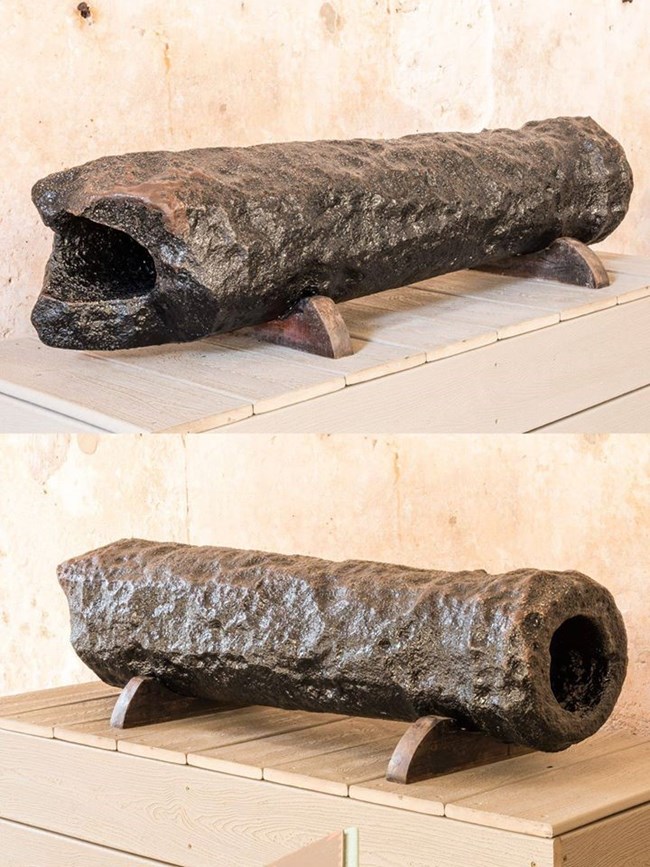Last updated: August 11, 2020
Article
Cannon Experiment

Did you know firing cannons harnessed the power of a chemical reaction to function? Conduct an experiment using the scientific method to produce a chemical reaction with an Alka-Seltzer cannons. Apply what you learn about chemical reactions to the loading and firing of cannon to understand the reality faced by the gun crews at the Castillo and Fort Matanzas.
Background: There are 36 pieces of artillery on the grounds of the Castillo, though some may be off for conservation, while at Fort Matanzas there are currently 4 cannons. They were cast, or made, between ca.1690 and 1846 from bronze and iron. Most forts preferred iron because it was cheaper and lighter, though bronze guns lasted longer and if they broke the metal could be reused. Today you can easily tell the difference between the iron and bronze cannon: the iron ones are black and very plain, while the bronze ones are green and have all sorts of decorations. The cannons at the Castillo are also a variety of different sizes from a small 2-pounder to the massive 32-pounder, depending on the size of the cannonball they fire. Cannons that fire larger cannonballs have greater range and do more damage but can’t be fired as fast as smaller cannon. All cannons, regardless of their size, function in the same manner. The firing of cannons is a process which relies on and harnesses the power chemical reactions. Now a chemical reaction is a process in which one or more substances (the reactants) are converted into one or more different substances (the products). To put it more plainly, during a chemical reaction the bonds between the atoms of a molecule are broken down and reorganized to create a new substance. To get a better understanding of how cannons and chemical reactions are related, let’s try a little experiment.
|
Experiment Steps |
|
STEP 1. 2-3 minutes: Review of Scientific Method (Question, Hypothesis, Materials, Procedures, Data and Analysis, and Conclusion). |
|
STEP 2. 5 minutes: Fill two cups halfway up with warm water. Place sugar cube in one cup and an Alka-Seltzer tablet in the other. Observe the difference between the reactions of the two solids when placed in the water. Record your observations on your paper. |
|
STEP 3. 10 minutes: Propose hypotheses: What will happen if the sugar cube/ water is covered when it dissolves? What will happen if the Alka-Seltzer tablet/water is covered when is dissolves? Record your predictions |
|
STEP 4. 5 minutes: Discuss safety precautions for the experiment: wearing safety glasses, standing back, making sure that there’s nothing for the cap to hit. |
|
STEP 5. 5 minutes: Fill one container 1/3 with water, add a sugar cube to the water, cover, and observe. Record your observations. |
|
STEP 6. 5 minutes: Use safety glasses to conduct the experiment. Fill one container 1/3 with water, add an Alka-Seltzer tablet to the water, quickly cover, step back, and observe. If it takes your cannon more than twenty seconds to fire, carefully re-try the experiment. It will make a loud noise and the lid will pop off, shooting into the air. Record your observations. |
|
STEP 7. 10 minutes: Discuss observations. What were the differences between the two reactions? Why would the top pop up? How high/far did it go? (The carbon dioxide gas formed when the Alka-Seltzer tablet dissolves, builds up pressure inside the sealed container until the enclosed area cannot contain it. The point of least resistance will pop. |
|
STEP 8. 20 minutes: Adding Variables: Re-try the experiment with another Alka-Seltzer tablet, use a whole tablet, ½ a tablet, 1/3 a tablet, or ¼. Try it with a crushed up tablet. Use a timer to record the amount of time it takes the top to pop. (Make sure that the water temperature is the same each time). Record observations after each variable to the experiment. |
|
STEP 9. 20 minutes: Discuss the results. Which variable sent the plastic top the furthest/highest? Which variable popped the top fastest? Why? |
|
STEP 10. 20 minutes: Draw a comparison between the different variables tested. Chart or graph the results from the experiment and complete your report with your conclusions. |


There were dangers that the soldiers at the Castillo and Fort Matanzas had to be aware of when they fired their cannon. The chemical reaction that they were using is far more dangerous than the one that created during this experiment. If the soldiers weren’t careful and didn’t follow all of the right steps the cannon might go off too early. When this happened it was very easy for them to get crushed, burned, or blasted. If the cannon had too much gunpowder loaded into it or the barrel was weak it could explode when it was fired. When this happened, the soldiers operating the cannon were likely to get badly hurt or even killed. During the Siege of 1702, a cannon exploded and the crew was killed. The remains of the barrel are on display at the Castillo. This meant that they needed to find the best way to load and fire their cannons so that they could hit far away targets, quickly, and safely. By safely harnessing a chemical reaction, very similar to your experiment, the soldiers at Castillo de San Marcos and Fort Matanzas were able to successfully defend themselves and the city of St. Augustine.
